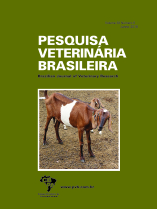 |
|
|
|
Year 2018 - Volume 38, Number 6
|

|
Testing a new surgical instrument to obtain bovine hoof biopsy samples, 38(6):1077-1084
|
ABSTRACT.- Mendes H.M.F., Rocha Júnior S.S., Paz C.F.R., Valadares R.C., Ribeiro R.M., Azevedo D.S.D., Vasconcelos A.C. & Faleiros R.R. 2018. Testing a new surgical instrument to obtain bovine hoof biopsy samples. [Teste de viabilidade de um instrumento cirúrgico para obtenção de biópsias do tecido laminar do casco de bovinos.] Pesquisa Veterinária Brasileira 38(6):1077-1084. Departamento de Clínica e Cirurgia Veterinária, Escola de Veterinária, Universidade Federal de Minas Gerais, Av. Antônio Carlos 6627, Cx. Postal 567, campus Pampulha, Belo Horizonte, MG 31270-901, Brazil. E-mail: faleirosufmg@gmail.com
The histological and molecular analysis of biopsy samples are fundamental steps for the understanding of physiopathology, diagnosis and prognosis of the diseases. However, harvest of tissue biopsies from hoof lamellar tissue is a procedure with limitations due to lack of effective surgical instruments and techniques. The aim of the current study is to develop and test in vivo a surgical instrument with the specific purpose of harvesting lamellar tissue in cattle. A prototype called Falcão-Faleiros’ lamellotome (INPIBR102013018765-8) was designed, produced and tested. After sedation, five adult cattle were restrained in lateral recumbency and locally anesthetized in two digits. The stratum corneum was worn down using a rotary tool coupled to a 3/8” high-speed cutter until the soft tissue proximity was reached. Next, the inner edge of the worn area was bounded with a scalpel. The lamellotome was introduced to obtain and hold the sample. The histological specimens of 16mm length by 6mm depth were stained with HE, PAS, Masson’s thricome and Shorr. The structures of interest were differentiated in the histological analysis without technical artifacts and a mean number of 85 epidermal laminae per sample were counted. No relevant lameness or wound complication were seen following the procedure. In conclusion the technique using the lamellotme was effective in obtaining lamellar tissue biopsy samples without causing clinical harm in cattle. The procedure showed potential to be used in clinical research or even as a supplementary diagnosis method for routine bovine podiatry. |
| |
|
|
| |
|
 |